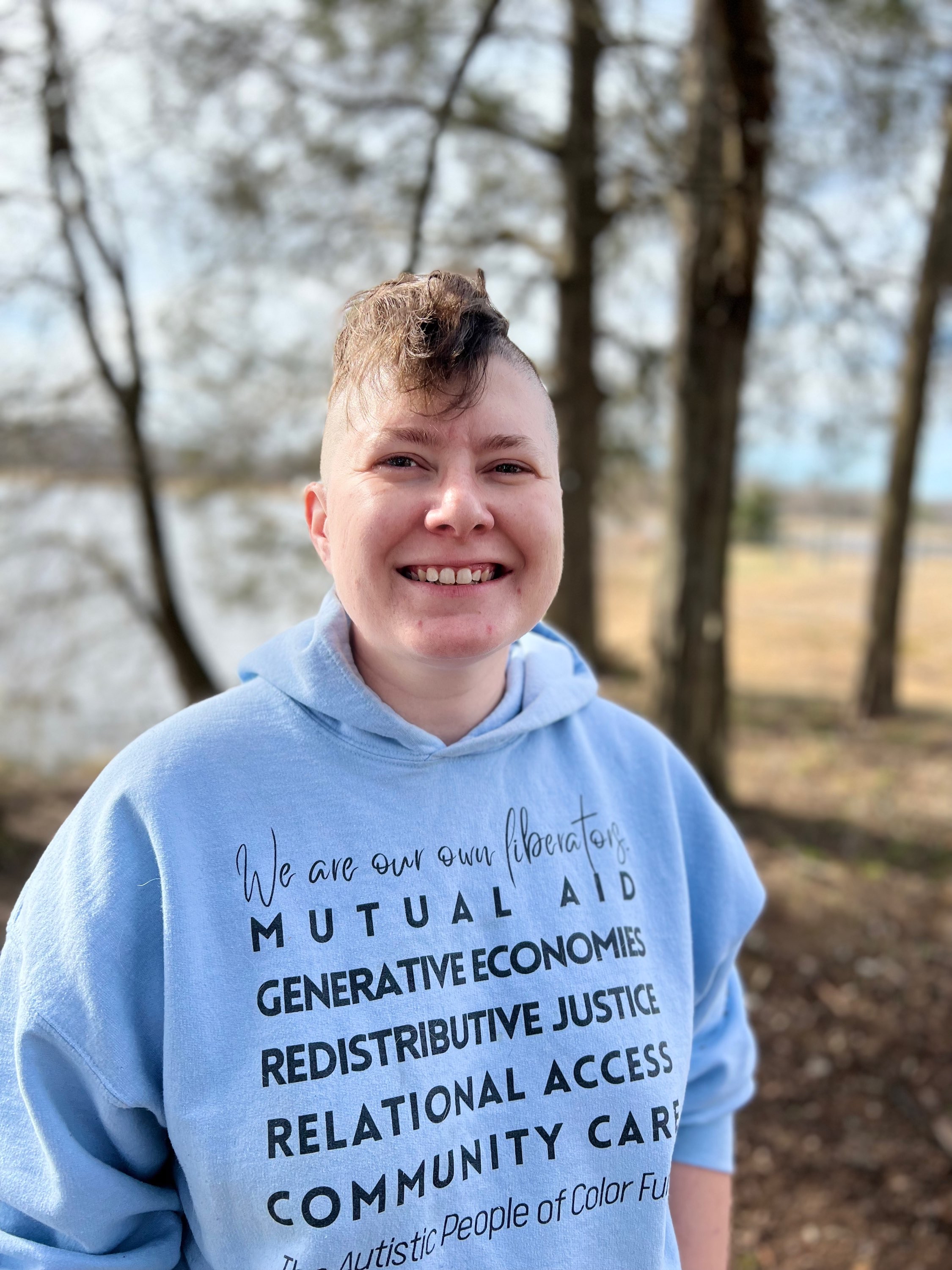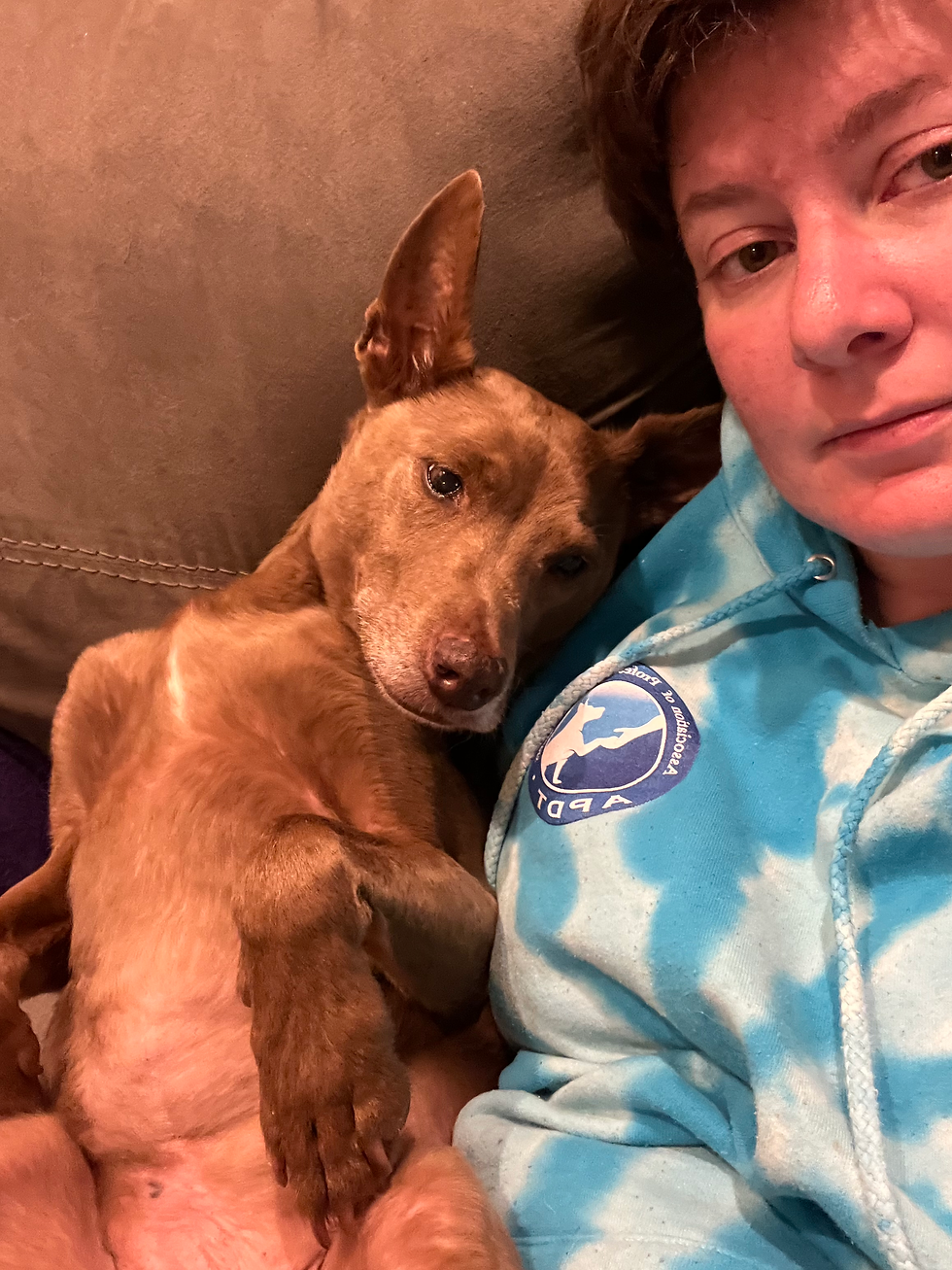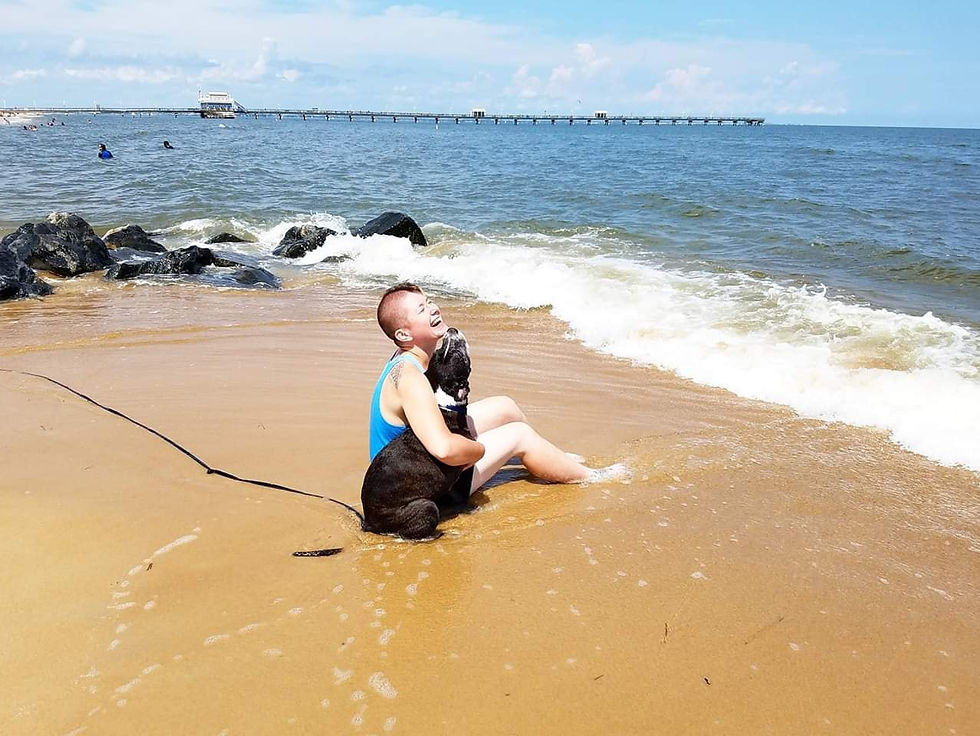Being Safe People
- Gabrielle Johnson

- Jul 26
- 10 min read

Safe relationships and safe places –
These are the two most essential ingredients for well-being. Without safety – safety within our relationships and safe places to exist – well-being will be compromised.
These foundations are even more important for dogs who already feel unsafe in the world. Dysregulated dogs – dogs with anxiety disorders, hyper- or hypo-arousal, who struggle with the impact of traumatic events, who experience chronic stress – need safety.
Without these foundational ingredients, other aspects of behavior therapy can’t be as impactful as they could be otherwise. It doesn’t matter if your dog knows how to move away from a situation in which they feel unsafe if there’s nowhere safe to go.
It will be more difficult to convince a dog that they’re safe from other dogs on a walk if they don’t trust the person holding their leash.
There are a lot of ways we make our dogs feel unsafe.
Sometimes, it’s unintentional. This is especially common with dysregulated dogs, or dogs who struggle to feel safe with people in a general sense. A sudden movement, a cough, the act of a person coming down the stairs can cause some dogs to panic.
Other times, we intentionally make our dogs feel less safe, though we might not think of it that way. We might yell at them, or shove them away, yank on their leash, or press a button. Sometimes these behaviors are a product of our own dysregulation; sometimes they’re systematic, intentional behaviors suggested by a “pet professional”.
Part of our work in behavior therapy, which is really the work of helping a dog to feel safe, is to ensure that we are part of the solution, and not working against ourselves.

Becoming a safe person: getting curious
The first step to becoming a safe person is to notice. To become aware. To listen.
Where, in your day-to-day life, is your dog afraid because of you or your behavior? Are they startled when you set up their x-pen and it clangs around? When you vacuum the carpet? When you yell at the TV?
Maybe there is an opportunity to move more slowly in rearranging the x-pen. Perhaps we can put some management into place while we vacuum or when emotion-provoking entertainment is on TV.
Perhaps we reassess how we show up for our dogs. When I yell at my dog for barking at the window, am I fostering the type of relationship I want to have with them? Am I giving them the experience they deserve in their own home? How might it feel for my dog to try to communicate something, or to engage in a behavior typical for their species, and to be punished for it? To find that expressing their feelings results in bearing the behavioral impact of their human being angry or annoyed. To reach out to connect – someone is here! I’m excited! I’m worried! Did you know someone is here? – and to be met with rejection?
Is this the relationship I want with my dog? Is this the person I want to be?

Healing our dogs means healing ourselves
Often, on this exploration of our own behaviors, we find that our behavior actually has very little to do with our dog and much more to do with us. This dive into our own psyche is not for the weak.
We may learn things about ourselves that are unfavorable. We may find ourselves faced with the fact that sudden, loud noises dysregulate us and become uncomfortable, realizing we are less in control of ourselves than we thought.
We may find that we hold notions of “respect” that need to be unpacked. We may realize that we’re operating from a hierarchical notion of control or entitlement that isn’t flattering when we pull it into the light to examine.
We may suddenly see that we’ve been acting on beliefs that we have consciously rejected – like that obedience is a moral imperative, or that our comfort matters more than someone else’s safety – or that perhaps we’re examining for the first time.
We may find that we’ve been failing to respect our dog’s boundaries. That we’ve been pushing them away. That we’ve been ignoring their needs. That we’ve been causing harm.
This might be crushing news. In fact, it may be so heavy that some people won’t be able to bear the weight of it. They’ll deflect. They’ll become defensive. They’ll justify.
That’s not an unusual reaction, and it could end everything right there.
But if we have the tools and the desire, we can keep going. We can stay in the light with the ugly thing and ask it questions. Pour it some tea. Settle in next to it, and ask, “Where did you come from?” and “What do you need?”

It isn’t about perfection.
I sometimes yell at my dogs. And not equally, either. My quiet, behaviorally dreamy, non-intrusive, sweet senior does not often engage in behavior that dysregulates me, which is when I am most likely to engage in behavior that, unchecked, damages my relationships.
Shadow is the one most likely to be on the receiving end of my dysregulation. He’s a loud guy. He can, in some ways, be wildly unaware of how his body appears in space. He has loud feelings and sometimes inconvenient needs.
I grew up with the messaging that I was too much. That the way I moved, and spoke, and engaged with others naturally was wrong. That stillness, submission, and quiet were the ways to stay safe. This would be damaging to any child, but being an Autistic and ADHD child added layers.
So when Shadow makes a loud, sudden noise, I struggle because of the Autism – it physically hurts my body, sending me into my sympathetic nervous system in a way similar to as if I had been punched.
And I struggle because of trauma – because in parts of my brain, being loud, emotional, taking up space, making oneself heard is associated with danger. And my wired reaction is to shut that shit down – for my safety, for his safety. It doesn’t matter that my cognitive brain knows we’re safe because this isn’t playing out in my thinking brain; it doesn’t matter that I know my own behavior is the most damaging piece of this scenario. This reaction is taking place in my survival brain, and it is not communicating with my thinking brain.

I have to tell you, just getting to the point that you can unpack what happened when you’re back in your thinking brain is a feat. It would be very easy to react and never examine our behavior in those moments. It would be most easy to just continue to the normalization of yelling at a barking dog. That is much easier than acknowledging that we have needs; that we are imperfect; that we are harmed and causing harm.
To notice that harm is being caused is huge. Especially when the fallout doesn’t impact us in the same way the initial behavior did. Because that bark hurt me. It caused me physical and emotional distress. It made my heart race. It adrenalized me.
And yelling made me feel better in the moment. It gave me an outlet – a space into which to displace some of that pain. It gave me a fleeting sense of control in a situation where I felt a loss of control.

And Shadow isn’t going to respond to me yelling by biting me, or cowering in a corner. The impact on him from my behavior won’t be as alarming to my nervous system as his bark was. It would be very easy to miss that any damage had occurred at all.
But if we listen. If we notice. If we become aware.
Now this next part is hard – this is where shame comes in. And sometimes we call it guilt, and that can exist too, but that overwhelming feeling that takes over our chest and paralyzes us? That’s shame. Shame is the feeling that says something is inherently wrong with us. That we are bad.
And shame feels very bad. It feels like a threat, in fact, because it is. If we are very wrong and very bad, we will lose our community. Others will reject us. And from a very evolutionary standpoint, that means death.
So shame serves a purpose – but can really get in our way here. Because it’s such an overwhelming and paralyzing feeling, we might become utterly hopeless – there’s nothing I can do, I’m a terrible person, and that’s just that. This might turn into more justifications for our behavior, because that’s easier than sitting with the shame.
We might become angry – our brains might shift the shame outward. We might believe that we feel this way because of our dog! My dog made me feel bad! Fuck that guy! And now we’re mad at the dog over something that has nothing to do with them, and everything to do with things we should probably be breaking down in therapy.
But there’s another option.
We can be kind to ourselves. We can give ourselves grace. We can treat ourselves with the same empathy and love we want to give our dogs. We can acknowledge that we’re doing the best we can, and that there is work to be done still. That we are in a process of growing and healing and learning to do better.
And then within that space, we are back in our thinking brain. We have capacity to hold our emotions – the anger, the terror, the pain, the shame, the anxiety, the embarrassment, the frustration, the grief – while remaining here.

It isn’t about perfection
If I set a goal to never yell at Shadow, I will likely fail. With my neurodivergences – the way I process sensory stimulation, my trauma history – it is unlikely that I can show up ideally in this relationship one hundred percent of the time, at least at this point in my life.
And that’s okay. Because it isn’t about perfection. Perfection is a tool of white supremacy, and it gets in the way of progress.
Instead, this is about approximations – and it’s about repair.
Approximations
Approximations of my goal: yell less often. Yell for a shorter time. Only yell, instead of yelling plus other damaging behaviors. Fall short of yelling, into more of an exacerbated tone that’s still harmful but not scary.
Repair sooner. Repair more generously.
When I’m in my thinking brain, and I’m able to acknowledge that my behaviors are a problem – they are causing harm; and when I’m not drowning in shame from this acknowledgement because I can hold space for my own imperfections; I can act.
I can be powerful and take control, not by exerting my will over someone with less power than me, but by modifying the environment.
I can (and have) put up window film. I can block noises. I can work on alternative behaviors for myself (like saying thank you to Shadow for telling me about the noise, asking him questions, going to the window to look at what he's asking me to see).

I can observe what is in my control, and make changes – I can be careful to know my own limits, to give myself the space to have limits, and try not to overload myself so that I can show up as the person I want to be in my relationships.
I can unpack concepts that need to be unpacked. I can go to therapy. I can heal. I can grow.
I can listen to my body when it’s hungry, tired, in need of movement, or rest, and meet those needs so that I’m harder to dysregulate.
I can notice what it feels like in my body to be approaching my limit, or to be in a space where I’m going to easily be triggered, and I can prepare for that. I can ask my partner to intervene. I can set up Shadow with an activity. I can move us to a different room in the house where the outside noises triggering the barking aren’t as loud. I can engage in behaviors that increase my capacity, like deep breaths or movement.
I can teach myself other ways to be dysregulated. I can sing instead of yell. I can engage in stimming behaviors that don’t hurt myself or others. I can leave the room.
I can be aware, so I can set myself up for success.
As a result, I lose control of myself less often.
And when I do lose it, I lose it with less intensity.
And I catch it happening sooner.
And I stop myself faster.
And behaviors that may have been on the table years ago, when I was earlier on in my own growth and healing, are no longer even in the room.

And then we repair.
I apologize to my dogs.
This isn’t accessible if we can’t make it to the stage of acknowledging harm. If we’re pretending harm doesn’t exist, we can’t even begin to consider repair.
I know that yelling at Shadow when he tries to communicate with me, when he has a big feeling, when he engages in a species-typical behavior, causes harm. Even if I don’t see a big emotional display from him as a response. Even if he doesn’t engage in overtly distressed behavior as a result.
So I take deep breaths. I catch myself. I don’t let myself drown in shame. I prioritize repair. I call him over – I invite him into my space. You are welcome here. You are wanted here.
I offer affection – and respect his response. I don’t allow petting him to be about making myself feel better – “let me pet you so we can have repair!” is a thought I have actively had to catch and examine. I do deserve to feel better, but that’s not what this is about.
I am the adult, and I have caused the harm. It is much more important in the moment to show Shadow that I can hear him, that I can prioritize his autonomy, that repair can happen on his schedule.
I talk softly. I say the words, “I’m sorry buddy. That scared me. I shouldn’t have yelled at you. You didn’t deserve that. You’re a good boy.”
He brings me his ball. I hold out my hand, but he doesn’t drop it. I don’t ask him to. I don’t wrestle it away. I consider that maybe he just wants to show it to me. Maybe he’s holding it to make himself feel better. Maybe he’s playing “only throw, no touch” which is a confusing game for humans, but one that many dogs enjoy.
This is about repairing harm I’ve caused – we can engage however he needs to right now.
I am aware. I notice. I listen.

This is how we become safe people.
Safe people aren’t perfect people.
Safe people are people who can acknowledge the harm they cause.
Who can separate intention from impact.
Who can hold contradictory ideas at the same time – “That barking is causing me pain and distress” and “That barking is normal dog behavior and a bid for connection”.
People who acknowledge that the more power we hold, the more careful we need to be.
Those are the safe people. Those are the people our dogs deserve in their lives. And that we deserve in ours.







Comments